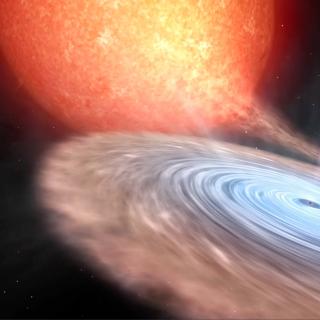García-Rojas, J.; Morisset, C.; Jones, D.; Wesson, R.; Boffin, H. M. J.; Monteiro, H.; Corradi, R. L. M.; Rodríguez-Gil, P.
Referencia bibliográfica
Monthly Notices of the Royal Astronomical Society
Fecha de publicación:
3
2022
Número de citas
43
Número de citas referidas
31
Descripción
We present MUSE deep integral-field unit spectroscopy of three planetary nebulae (PNe) with high-abundance discrepancy factors (ADF > 20): NGC 6778, M 1-42, and Hf 2-2. We have constructed flux maps for more than 40 emission lines, and use them to build extinction, electron temperature (Te), electron density (ne), and ionic abundances maps of a number of ionic species. The effects of the contribution of recombination to the auroral [N II] and [O II] lines on Te and the abundance maps of low-ionization species are evaluated using recombination diagnostics. As a result, low Te values and a downward gradient of Te are found toward the inner zones of each PN. Spatially, this nearly coincides with the increase of abundances of heavy elements measured using recombination lines in the inner regions of PNe, and strongly supports the presence of two distinct gas phases: a cold and metal-rich and a warm one with 'normal' metal content. We have simultaneously constructed, for the first time, the ADF maps of O+ and O2+ and found that they centrally peak for all three PNe under study. We show that the main issue when trying to compute realistic abundances from either ORLs or CELs is to estimate the relative contribution of each gas component to the H I emission, and we present a method to evaluate it. It is also found that, for the studied high-ADF PNe, the amount of oxygen in the cold and warm regions is of the same order.
Proyectos relacionados
![Izquierda - Imagen RGB de la nebulosa de Orión y M43 obtenida filtros estrechos con la cámara WFC en el INT: H alfa (rojo), [S II] 6716+30 (verde), [O III] 5007 (azul). Derecha - Imagen en falso color de la nebulosa planetaria NGC 6778. En azul se ve la emisión en la línea de O II tomada con el filtro sintonizable azul del instrumento OSIRIS en el GTC; en verde imagen con el filtro estrecho de [O III] del Nordic Optical Telescope (NOT). Izquierda - Imagen RGB de la nebulosa de Orión y M43 obtenida filtros estrechos con la cámara WFC en el INT: H alfa (rojo), [S II] 6716+30 (verde), [O III] 5007 (azul). Derecha - Imagen en falso color de la nebulosa planetaria NGC 6778. En azul se ve la emisión en la línea de O II tomada con el filtro sintonizable azul del instrumento OSIRIS en el GTC; en verde imagen con el filtro estrecho de [O III] del Nordic Optical Telescope (NOT).](/sites/default/files/styles/crop_square_2_2_to_320px/public/images/project/imagen_web.jpg?itok=fsBmV9CO)
Física de Nebulosas Ionizadas
Este proyecto mantiene dos líneas principales de investigación activas: 1) Estudio de la estructura, condiciones físicas y composición química de las nebulosas ionizadas, tanto galácticas como extragalácticas, a través del análisis detallado y modelización de sus espectros. El enfoque de estudiar en detalle nebulosas cercanas a través de espectros
Jorge
García Rojas

Agujeros negros, estrellas de neutrones, enanas blancas y su entorno local
Los agujeros negros y estrellas de neutrones en binarias de rayos-X son laboratorios únicos para explorar la física de estos objetos compactos. No solo permiten confirmar la existencia de agujeros negros de origen estelar a través de mediciones dinámicas de sus masas, sino que también permiten investigar el comportamiento de la materia y la
Montserrat
Armas Padilla